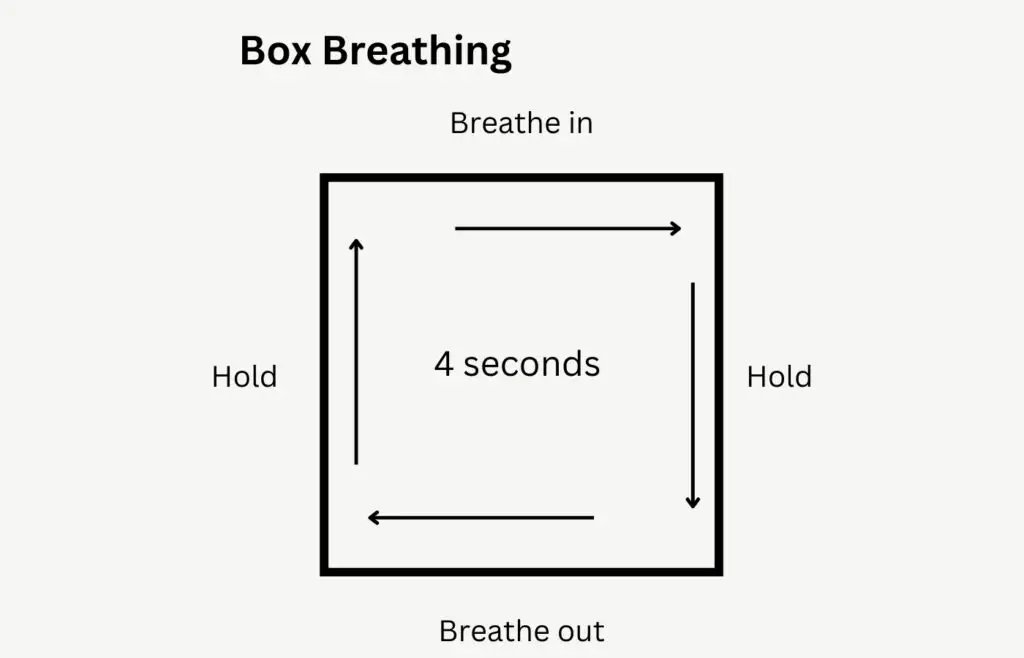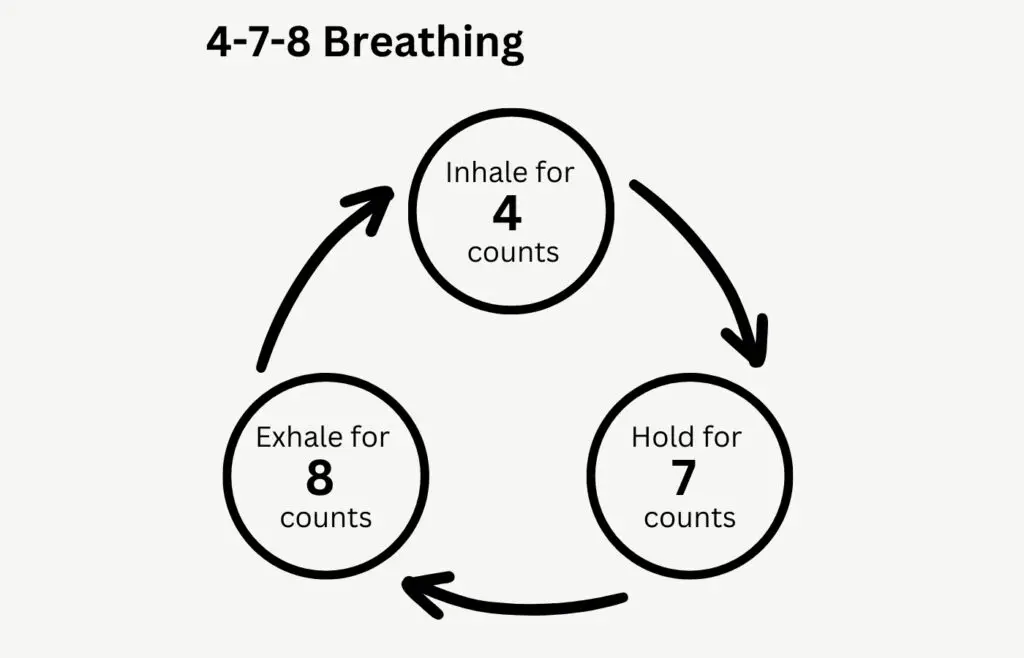
Which One Is The Best: Box Breathing vs 4-7-8 Breathing
You may have heard of breathing techniques such as Box breathing and the 4-7-8 technique. Both are renowned for their simplicity and effectiveness, but what exactly are they and how can you decide which to choose? Today we will investigate Box breathing vs 4-7-8 breathing — so you can understand what sets them apart and determine which one is more suitable for you and your personal needs.
Box breathing involves inhaling, holding your breath, exhaling, and then holding your breath again. Each of these steps is completed to a count of four, creating a ‘box’ or ‘square’ pattern.
On the other hand, the 4-7-8 breathing technique is a practice that involves inhaling for 4 seconds, holding your breath for 7 seconds, and then exhaling slowly over 8 seconds.
Both techniques use conscious breathing to improve focus, reduce anxiety, enhance sleep quality, and more. The key is to understand the differences between them and choose the right one based on your needs and goals. Let’s explore each technique in detail.
Table of Contents
ToggleAffiliate disclosure: some of the links on this site are affiliate links, meaning at no additional cost to you, I will be earning a commission if you click through and purchase.
Understanding Box Breathing Technique

The Box breathing technique is a powerful strategy used by Navy SEALs to improve focus and manage stress. This exercise involves breathing in a balanced rhythm, which helps to clear the mind and regulate emotions. By counting and coordinating each breath, it creates a sense of harmony between the body and mind, preparing individuals to tackle tasks with increased concentration.
When to Use Box Breathing Technique
Knowing when to use Box breathing can maximize its effectiveness. Here are some situations where this technique can be particularly helpful:
Pre-Workout Focus: Before starting any physical activity, doing a few rounds of Box breathing can oxygenate the body and sharpen focus, leading to a more productive workout.
Moments of Intense Anxiety: During times of high stress or anxiety, practicing this technique can provide instant relief, calming the nervous system and restoring emotional balance.
Before Important Meetings or Presentations: It can be beneficial to use Box breathing before stepping into situations where there is pressure to perform well. This helps to clear the mind and boost confidence.
High-Stress Work Environments: Finding moments throughout the day to practice Box breathing can help reduce stress levels and recharge mental energy in demanding work environments.
Study Sessions: When studying for long periods, it’s common for concentration to decline. Using this technique can help refocus attention and improve information retention.
Feeling Overwhelmed: During moments when emotions are overwhelming and clouding rational thinking, Box breathing offers a structured pause to regain composure.
By incorporating this exercise into daily life, individuals have a tool readily available to manage stress whenever needed. Whether it’s preparing for an important task or dealing with unexpected challenges, Box breathing can help regulate one’s internal state.
How to Practice Box Breathing Technique

Practicing the Box breathing technique is straightforward and remarkably effective. It works wonders for focus enhancement, building stress resilience, and empowering emotional control. Here’s how to harness the power of this breathing method:
Step-by-Step Guide:
Find a Quiet Space: Minimize distractions to fully engage with the exercise.
Comfortable Position: Sit with a straight back or lie down, whichever feels best for you.
Inhale Slowly: Breathe in steadily through your nose to a slow count of four.
Hold Your Breath: Gently keep the air inside your lungs for another count of four.
Exhale Gradually: Release the air through your mouth over a four-count, ensuring a consistent flow.
Pause Again: After exhaling, gently hold your breath out for the same count of four.
Repeat this cycle for at least five minutes. If you find the length of each cycle too long or too short, feel free to experiment, as long as you keep each cycle the same length. There’s no one-size-fits-all rule.
Benefits Include:
Enhanced Concentration: Clearer mind for tackling tasks and projects
Stress Response Improvement: Quick stress reduction in high-pressure situations
Emotional Stability: Greater control over emotional reactions
By integrating box breathing into your daily life, you’ll notice not just an instant calm but also long-term benefits such as improved focus and emotional regulation. Remember to keep practicing—it’s about consistency and making this technique a staple of your wellbeing toolkit.
For a more in-depth article on box breathing, its effects on your body, and how you can customize it to your liking, check out our blog “What Is Box Breathing And How Should It Be Performed?“.
Next, let’s explore how it holds up in the comparison of Box breathing vs 4-7-8.
Exploring the 4-7-8 Breathing Technique

Who knew that something as simple as breathing could be so profound? Enter the 4-7-8 Breathing Technique, a revolutionary approach crafted by Dr. Andrew Weil. This practice places emphasis on a longer exhale, making it an ideal tool for relaxation and sleep.
Unlike Box breathing where all parts of the breath are equally timed, 4-7-8 introduces a different rhythm. As its name suggests, this breathing method involves inhaling for four counts, holding the breath for seven counts, and exhaling slowly over eight counts. The elongated exhale is key to this method’s calming effects.
When to Use the 4-7-8 Breathing Technique
The perfect moment to try out this technique might just be lurking in your daily routine.
Many people are restless before bedtime, finding it hard to switch off their brains and relax into sleep. The 4-7-8 breathing exercise could be just the ticket for better nights. It’s like a lullaby for the nervous system, helping you wind down and prepare for restful slumber.
Imagine this scenario: You’re lying in bed after a long day, your mind buzzing with thoughts and worries. Instead of reaching for your phone or dwelling on these thoughts, rehashing every little detail, you decide to try the 4-7-8 breathing technique. As you start to follow its rhythm — inhale, hold, exhale — you notice your body responding. Your heart rate slows down, your muscles start to relax… before you know it, you’re drifting off into peaceful sleep.
But this exercise is not limited to bedtime. Any moment of restlessness or anxiety is an opportunity to practice this technique. Whether you’re stuck in traffic, waiting at a doctor’s office, or feeling overwhelmed at work — just a few cycles of 4-7-8 breathing can help restore calmness and balance.
Adapting this method into your daily life can lead to measurable improvements in sleep quality, anxiety reduction, and heart rate variability — a key indicator of stress resilience and overall well-being.
Remember, taking control over your breath means taking control over your life. So why not give 4-7-8 breathing a try? Your body and mind might just thank you for it.
How to Practice the 4-7-8 Breathing Technique

The 4-7-8 breathing technique is an easy but effective way to achieve a state of deep relaxation and improve sleep.
One key aspect of this practice is the longer exhale. It is important as it helps to calm the nervous system and improve heart rate variability. Unlike box breathing, it is specifically good for helping you relax and get ready for sleep.
Here’s your step-by-step guide to practicing the 4-7-8 breathing technique for relaxation and sleep support:
Find a Comfortable Position: Sit with your back straight or lie down in bed if you’re preparing to sleep.
Exhale Completely: Begin by gently exhaling through your mouth, making a whoosh sound to empty the lungs.
Inhale Through Your Nose: Close your mouth and silently inhale through your nose while mentally counting to four.
Hold Your Breath: After the inhalation, gently hold your breath for a count of seven.
Exhale With Sound: Exhale fully through your mouth for a count of eight, making the same whooshing sound as before.
Repeat the Cycle: Complete this cycle for four full breaths to start. Gradually work up to eight full cycles.
Consistent practice can lead to improved sleep quality, decreased anxiety levels, and enhanced cognitive function. It’s important not just to focus on the count but also on the quality of breath: it should be smooth, steady, and soundless on inhalation, with a relaxed whoosh on exhalation.
This exercise can be seamlessly integrated into your evening routine or utilized during moments throughout the day when anxiety reduction is needed. Remember that it takes time to feel comfortable with new breathing patterns—patience and persistence are key.
If you want to dive deeper into the 4-7-8 technique, how it works, and its profound benefits, check out our blog “How To Breathe To Reduce Stress: The Amazing 4-7-8 Technique?“.
Box Breathing vs 4-7-8 Breathing

In the pursuit of calmness and mindfulness, both Box breathing and the 4-7-8 breathing technique are popular breathing exercises. Each method has its own unique benefits and purposes.
Box Breathing: Finding Balance and Focus
Box breathing is known for its symmetrical pattern of inhaling, holding, exhaling, and holding again, with each phase lasting a count of four. This technique offers a balanced rhythm that can stabilize your mood and sharpen your concentration, especially good for staying focused and resilient in high-pressure situations.
Box breathing is like a steady beat, each phase equal in length, creating an overall sense of balance and equilibrium. It’s akin to an anchor in tumultuous seas; it can center your focus and calm your mind whether you’re gearing up for an intense workout or navigating through a spike in anxiety.
4-7-8 Breathing: Relaxation and Sleep Aid
On the other hand, the 4-7-8 Breathing Technique places emphasis on the exhale to usher in relaxation and prepare the body for sleep. The fundamental difference lies in the extended exhale duration—twice as long as the inhale—which is key to reducing heart rate variability and easing the nervous system into a state of restfulness.
4-7-8 breathing, with its prolonged exhalation, acts as a gentle lullaby for your nervous system. Imagine drawing the curtains at dusk; it’s about winding down from the day’s hustle and quieting your internal chatter. This method particularly excels at setting the stage for a restful night’s sleep or when you need to dial down heightened stress levels.
Both practices offer their own benefits, so it’s worth exploring and incorporating them into your daily routine based on your particular needs and what suits you the best.
Choosing the Right Technique for Your Needs

Crafting a personalized routine for stress management, focus improvement, or sleep quality enhancement? The choice between box breathing vs 4-7-8 technique rests on several factors.
Your Current Challenges
Think about what you’re wrestling with right now. Is it a lack of focus? Or perhaps you’re constantly under stress? The box breathing method is excellent at enhancing focus and building stress resilience. But if sleep eludes you or restlessness is your constant companion, the 4-7-8 technique could help promote relaxation and improve sleep quality.
Your Personal Goals
Next, consider your personal objectives. Are you seeking to improve concentration and stamina? Want to gain better emotional control? Box breathing can be a great ally in these pursuits. On the other hand, if your goal is to relax your muscles and nervous system, manage anxiety for restful sleep, or enhance emotional well-being, the 4-7-8 technique might be more suitable.
Your Daily Routine
Lastly, factor in your daily routine. Can you spare at least five minutes during the day before stress hits or as a focus tool every day for box breathing? If finding quiet moments before bedtime or during periods of anxiety is easier for you, consider the 4-7-8 technique.
Remember that both exercises offer better stress management, improved concentration, and enhanced well-being when practiced consistently over weeks. Feel free to experiment with both and see what works best for you.
Conclusion

Embarking on the journey toward stress management mastery can be made easier with the right tools in your wellness kit. Breathing exercises, such as Box breathing and the 4-7-8 technique, provide a cost-effective, easy-to-implement strategy for achieving sustained inner peace and serenity.
Experimentation is key. You are not restricted to choosing one over another. Feel free to try both Box breathing and the 4-7-8 breathing exercise at different times or situations to determine which one resonates best with your unique needs and circumstances.
Remember, consistency is critical. Whether you resonate more with Box breathing for focus and calmness during the day or rely on the 4-7-8 technique for relaxation and sleep aid, incorporate these practices into your daily routine for maximum benefit.
Breathing exercises can be greatly enhanced with guided apps like Headspace, Calm, Breethe, or TheMindfulnessApp. These apps offer customizable sessions that guide you through each step of the breathing process. For a comprehensive list of apps to try out, check out our blog “Breathe Easy: The 10 Best Apps for Breathing Exercises“.
So are you ready to take control of your stress levels? Start by doing your own comparison of Box breathing vs 4-7-8, and incorporate these proven breathing techniques into your daily routine. Your path to tranquility awaits!
Leave a reply
Got any questions or want to share which technique resonates the most with you? Let me know in the comments below!






4 Comments
Sheenia
14/05/2024 at 8:58 AM
I didn’t know that there were so many different breathing techniques. Focusing on my breath always puts me at ease. Thanks for sharing this!
Marta Chmyzinska Chmyzinska
14/05/2024 at 3:52 PM
As someone who suffers from panic attacks almost daily, I apreciate this.
breatheintocalm.com
16/05/2024 at 6:04 AM
I really feel with you, Marta! Focussing on your breathing during heightened stress and anxiety often helps take the mind off the situation and anchor your body in the present moment.
breatheintocalm.com
16/05/2024 at 6:06 AM
I am so glad you found it useful, Sheenia! There are many exercises and techniques, so try out a few and see which resonates with you. You might find that some techniques work better in some situations, whereas something totally different works better at other times. 🙂